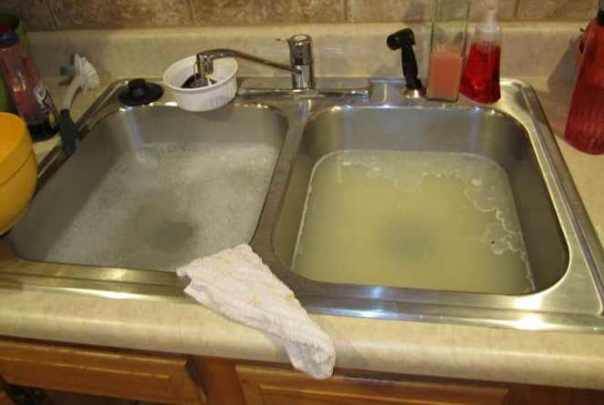A clogged sink can be a major nuisance, but it generally happens to most of the homeowners at some time of another. A clogged sink is usually caused by dirt, gunk and hair buildup and can be difficult to remove. People often use a harsh chemical to dissolve the clogs, some natural options exists that can keep the noxious solution out of our home and can save your money. Manual options are also available such as plunging the clog or snaking your drain, are often the easiest way to naturally remove a block. However, some homemade solutions and enzyme based drain agents can also help you to dissolve a block if manual power alone does not work. Read more to know ways to unclog a sink.

Ways to Unclog a Sink
1.) Plunger to Unclog a Sink
The plunger works very effectively, it can unclog a sink just as easily as it can unclog your toilet. Be sure to clean the plunger before using it on your sink, or buy a new plunger for use in the sink.
- Cover the drain opening completely with the help of plunger
- The pump the plunger up and down several times to loosen the clog.
- Remove the plunger after a minute or work to see if water will flow down the sink. If the sink is still clogged then continue to plunge to further loosen the blockage.
2.) Use a Wire Coat Hanger to Unclog a Sink
Bend a wire coat hanger into a straight with the curved hook at one end. Then slide the wire hook first down your clogged drain and see if you can hook and remove or otherwise break apart any portions of the blockage.
- Push the hanger down until you feel some resistance then, shake the hanger up and down and side to side and try to get it to latch onto the block.
- Once you will find that you have hooked the block, then pull the hanger up to clear out whatever you have caught.
- If you don’t feel the resistance as you push the hanger down, there is a chance that your clog is lower and you need a specialty tool.
3.) Snake your Drain
A drain snake is a long metal cable with a coil or auger on the end that helps it manually to remove the blockages from drains. Buy a drain snake approximately sized of your sink at your local hardware or home improvement store to help you to unclog a sink.
- Feed the snake into the drain and push on downward until you feel some resistance from the clog.
- Once you have hit he clog then turn the cable clockwise for three to four rotations, then pull up somewhat. If you find some resistance, you have likely hooked on the clogged matter.
- Continue to rotate the drain snake until you push through the entirety of the clog and started to break it into the smaller pieces.
- When you find that resistance starts to lessen then pull the snake out slowly and remove what is left of the clog from the end auger.
- You need to check to make sure that your drain is unclogged. If water still will not flow down properly then repeat the snake process.
4.) Vinegar and Baking Soda to Unclog a Sink
Baking soda and vinegar can help to loosen the clogs in your drain by dissolving and pushing gas into the clog. Don’t use this method on the metallic pipes, drains baking soda may corrode the pipe surface and leach metals from your water into your pipes.
- Remove your drain cover and pour half a cup of baking soda directly into your drain. You may want to use a funnel to help get the product down.
- Put the baking soda with half a cup of distilled white vinegar.
- Then allow the mixture to bubble and frizz in drain for up to 15 minutes. Once the bubbling has stopped then wash your drain out with your tap water on its hottest setting.
5.) Make a Hydrogen Peroxide Solution
Take one cup of hydrogen peroxide in every quart of cold water to make a solution. Then pour this down and allow it to sit for 15 to 20 minutes before rinsing out tap water on its warmest setting.
- Be cautious while using hydrogen peroxide, as concentrated version of it can cause chemical burns on the skin if not monitored properly.
- If you have previously tried a baking soda cleaner so don’t use hydrogen peroxide
6.) Wet and Dry Vacuum to Unclog a Sink
If you have a wet and dry shop vacuum, then it can become a terrific tool to unclog the drain. First, you need to set it to vacuum liquids. Cover up the vent to prevent a mess. Then create the tightest seal you can over the drain. You will like to get creative and adapt an old plunger head for this purpose. With the vacuum turned on its highest setting, it can be very powerful enough to draw the clog up the pipe and into the vacuum bag. it doesn’t work always but it’s a worth a shot.
7.) Unclog a Sink with Boiling Water
This is one of the easiest ways to unclog a sink. You need to put the kettle on and boil as much as water as it will hold. Now it slowly down the drain in two to three stages, the allow the hot water to work for a couple of minutes in between each pour. This is usually the one of the easiest and quickest ways
8.) Caustic Soda to Unclog a Sink
You need to get some gloves and eye protection for this method. Caustic soda is also known as sodium hydroxide and can cause nasty chemical burns. You can buy it from your local hardware store, but always use caution while handling it. pour a ¾ gallon of cold water into a mop bucket and then 3 cups of caustic soda. Stir it well with an old wooden spoon. It will begin to frizz and then heat up. Pout it into unclogged drain and leave if for about 20 to 30 minutes, then flush the drain with boiling water. Use this method as necessary.
9.) Salt and Baking Soda
You need to mix a half cup of baking soda with a half cup of table salt and then pour down the blocked drain. Leave it for about 10 to 20 minutes the pour the boiling down down. The baking soda, salt, and boiling water will produce a chemical reaction that should dissolve some of the nastiest blockages
10.) Dish Detergent to Unclog a Sink
If you sink is clloged then you pour ¼ cup of dish detergent in the bowl. Then boil some water. The dish soap will act as a lubricant and help to break up any grease residue. Then pour the hot water down and get ready to start for plunging. If the plunger doesn’t cut it then rubber gloves cold be your next option.
11.) Baking Soda, Vinegar, Gravity, and Pressure
You can also use this if your bath drain is clogged, you need to mix some baking soda and vinegar. Then pour it into the drain, and then place the stopper over it. after 50 to 60 minutes fill the bathtub with water, then remove the stopper. The pressure of 50 to 60 gallons of water would be enough to dislodge the blockage that has been loosened by the vinegar and baking soda.
12.) Preventing Future Clogs Naturally
- Keep food out- If if you have a garbage disposal, it is recommended that you should keep food out of your drains as much as possible. You will need to scrape food off from the trash can before rinsing. Use the disposal only for those small pieces that could not make it to the trash.
- If you use your disposal, make sure to put food down on small amount at a time and run plenty of water while the disposal is running.
- Install Screen –You need to install screens or use drain catchers over your bathroom and kitchen sinks to help prevent foods, hair and other debris from going down the drain. Drian catches are often affordable and can generally be found at home goods and home improvement stores.They are also advisable for tub and shower drains to help prevent hairs from causing clogs in your pipes
- Run Hot Water- It helps to break apart grease and dirt by running hot water down your drain once a week of after heavy use. Turn your tap water onto it hottest setting, and allow its water to flow down your pipes for two to three minutes to help loosen potential clog causing debris.
- Do not heat tap water by microwaving or boiling it, as water that is too hot has the potential to harm your pipes.
You can also have look at similar articles:
















